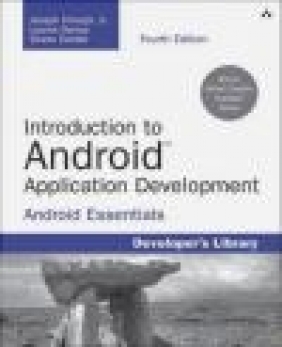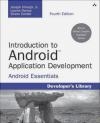Introduction to Android Application Development
Lauren Darcey, Shane Conder, Joseph Annuzzi
Introduction to Android Application Development
Lauren Darcey, Shane Conder, Joseph Annuzzi
- Producent: Addison Wesley Publishing Company
- Rok produkcji: 2013
- ISBN: 9780321940261
- Ilość stron: 672
- Oprawa: Miękka
Niedostępna
Opis: Introduction to Android Application Development - Lauren Darcey, Shane Conder, Joseph Annuzzi
Bonus KitKat material is available for download at www.informit.com/title/9780321940261 What Every Android(TM) App Developer Should Know Today: Android Tools, App/UI Design, Testing, Publishing, And More This fully reworked edition of a proven title is the most useful real-world guide to building robust, commercial-grade Android(TM) apps. The content is revised and updated for the latest Android 4.3 SDK and the newest development best practices. Introduction to Android(TM) Application Development: Android Essentials, Fourth Edition, covers all you need to quickly start developing professional apps for today's Android devices. Three expert developers guide you through setting up your development environment, designing user interfaces, developing for diverse devices, and optimizing your entire app-development process-from design through publication. Updated throughout, this title includes extensive coverage of the most useful new Android tools and utilities. It adds an all-new chapter on planning an amazing Android app user experience, plus extensive new coverage of unit testing, dialogs, preferences, and app publishing. Throughout, key concepts are taught through clear, up-to-date example code. This edition offers * Fully updated introductions to the latest Android 4.3 APIs, tools, utilities, and best practices * Up-to-date strategies for leveraging new Android capabilities while preserving compatibility * Navigation patterns and code samples for delivering more intuitive user experiences * Example-based explanations of ActionBars, DialogFragments, and other key concepts * Expert automated testing techniques to quickly improve code quality * New Google Play Developer Console app publishing techniques that also offer more control For Android developers at all levels of experience, this reference is now more valuable than ever. Students, instructors, and self-learners will especially appreciate new chapter-ending questions and exercises, carefully designed to test knowledge and deepen mastery. Annuzzi has released new source code samples for use with Android Studio. The code updates are posted to the associated blog site: http://introductiontoandroid.blogspot.com/ Note: This revamped, newly titled edition is a complete update of Android(TM) Wireless Application Development, Volume I: Android Essentials, Third Edition Praise for Introduction to Android(TM) Application Development, Fourth Edition "Introduction to Android Application Development, Fourth Edition is a phenomenal read and allows those interested in Android development to be brought up to speed and developing apps with minimal fuss. Everything from an introduction to the Android ecosystem and setting up a development environment to creating and publishing Android applications is covered in depth and with technical expertise. Those who crave even more from the book will be treated to a feast of useful links at the end of each chapter to help guide them on and expand their new-found knowledge base." -Philip Dutson, UX and Mobile Developer for ICON Health & Fitness "With this edition, you won't find a more solid and comprehensive introduction to Android programming. Even if you already have another Android book, Introduction to Android App Development makes a good second reference." -Douglas Jones, Senior Software Engineer, Fullpower Technologies "Introduction to Android Application Development, Fourth Edition is an important update to this invaluable reference for new and seasoned Android developers. It brings the latest up-to-date information about the newest releases of Android, showing you how to keep your application fresh on yesterday's, today's, and tomorrow's Android devices." -Ray Rischpater, Senior Software Engineer, MicrosoftAcknowledgments xxxi About the Authors xxxiii Introduction 1 Who Should Read This Book 1 Key Questions Answered in This Book 2 How This Book Is Structured 2 An Overview of Changes in This Edition 3 Development Environments Used in This Book 5 Supplementary Materials Available 6 Where to Find More Information 6 Conventions Used in This Book 7 Contacting the Authors 7 Part I: An Overview of the Android Platform Chapter 1: Introducing Android 11 A Brief History of Mobile Software Development 11 The Open Handset Alliance 18 Android Platform Differences 23 The Android Platform 29 Summary 36 Quiz Questions 36 Exercises 36 References and More Information 36 Chapter 2: Setting Up Your Android Development Environment 37 Configuring Your Development Environment 37 Exploring the Android SDK 43 Summary 52 Quiz Questions 52 Exercises 53 References and More Information 53 Chapter 3: Writing Your First Android Application 55 Testing Your Development Environment 55 Building Your First Android Application 68 Summary 92 Quiz Questions 93 Exercises 94 References and More Information 94 Part II: Android Application Basics Chapter 4: Understanding the Anatomy of an Android Application 97 Mastering Important Android Terminology 97 The Application Context 98 Performing Application Tasks with Activities 99 Organizing Activity Components with Fragments 105 Managing Activity Transitions with Intents 106 Working with Services 110 Receiving and Broadcasting Intents 111 Summary 112 Quiz Questions 112 Exercises 112 References and More Information 113 Chapter 5: Defining Your Application Using the Android Manifest File 115 Configuring Android Applications Using the Android Manifest File 115 Managing Your Application's Identity 122 Enforcing Application System Requirements 123 Registering Activities in the Android Manifest 129 Working with Permissions 131 Exploring Other Manifest File Settings 133 Summary 133 Quiz Questions 134 Exercises 134 References and More Information 135 Chapter 6: Managing Application Resources 137 What Are Resources? 137 Setting Simple Resource Values Using the Android IDE 143 Working with Different Types of Resources 146 Working with Layouts 166 Referencing System Resources 171 Summary 172 Quiz Questions 173 Exercises 173 References and More Information 173 Part III: Android User Interface Design Essentials Chapter 7: Exploring User Interface Building Blocks 177 Introducing Android Views and Layouts 177 Displaying Text to Users with TextView 179 Retrieving Data from Users with Text Fields 183 Giving Users Choices Using Spinner Controls 188 Allowing Simple User Selections with Buttons and Switches 190 Retrieving Dates, Times, and Numbers from Users with Pickers 197 Using Indicators to Display Progress and Activity to Users 199 Adjusting Progress with Seek Bars 202 Other Valuable User Interface Controls 203 Summary 207 Quiz Questions 207 Exercises 207 References and More Information 208 Chapter 8: Designing with Layouts 209 Creating User Interfaces in Android 209 Organizing Your User Interface 214 Using Built-in Layout Classes 215 Using Container Control Classes 232 Summary 239 Quiz Questions 239 Exercises 240 References and More Information 240 Chapter 9: Partitioning the User Interface with Fragments 243 Understanding Fragments 243 Using the Android Support Package 258 Exploring Nested Fragments 261 Summary 261 Quiz Questions 262 Exercises 262 References and More Information 263 Chapter 10: Displaying Dialogs 265 Choosing Your Dialog Implementation 265 Exploring the Different Types of Dialogs 266 Working with Dialogs and Dialog Fragments 267 Working with Support Package Dialog Fragments 271 Summary 275 Quiz Questions 276 Exercises 276 References and More Information 276 Part IV: Android Application Design Essentials Chapter 11: Using Android Preferences 281 Working with Application Preferences 281 Finding Preferences Data on the Android File System 285 Creating Manageable User Preferences 286 Learning about Cloud Save for Android Applications 296 Summary 298 Quiz Questions 298 Exercises 299 References and More Information 299 Chapter 12: Working with Files and Directories 301 Working with Application Data on a Device 301 Practicing Good File Management 302 Understanding Android File Permissions 303 Working with Files and Directories 303 Summary 312 Quiz Questions 312 Exercises 313 References and More Information 313 Chapter 13: Leveraging Content Providers 315 Exploring Android's Content Providers 315 Modifying Content Provider Data 324 Using Third-Party Content Providers 328 Summary 328 Quiz Questions 328 Exercises 329 References and More Information 329 Chapter 14: Designing Compatible Applications 331 Maximizing Application Compatibility 331 Designing User Interfaces for Compatibility 333 Providing Alternative Application Resources 338 Targeting Tablets, TVs, and Other New Devices 347 Targeting Google Chromecast Devices 350 Summary 350 Quiz Questions 350 Exercises 351 References and More Information 351 Part V: Publishing and Distributing Android Applications Chapter 15: Learning the Android Software Development Process 355 An Overview of the Mobile Development Process 355 Choosing a Software Methodology 356 Gathering Application Requirements 357 Assessing Project Risks 364 Writing Essential Project Documentation 368 Leveraging Configuration Management Systems 369 Designing Mobile Applications 370 Developing Mobile Applications 373 Testing Mobile Applications 373 Deploying Mobile Applications 374 Supporting and Maintaining Mobile Applications 375 Summary 377 Quiz Questions 377 Exercises 377 References and More Information 378 Chapter 16: Designing and Developing Bulletproof Android Applications 379 Best Practices in Designing Bulletproof Mobile Applications 379 Avoiding Silly Mistakes in Android Application Design 388 Best Practices in Developing Bulletproof Mobile Applications 388 Summary 393 Quiz Questions 394 Exercises 394 References and More Information 394 Chapter 17: Planning the Android Application Experience 395 Thinking about Objectives 395 Techniques for Focusing Your Product Efforts 397 Charting Your Application's Navigation 400 Encouraging Action 408 Communicating Your Application's Identity 416 Designing Screen Layouts 417 Reacting Properly with Visual Feedback 418 Observing Target Users for Usability 418 Summary 419 Quiz Questions 420 Exercises 420 References and More Information 420 Chapter 18: Testing Android Applications 423 Best Practices in Testing Mobile Applications 423 Android Application Testing Essentials 435 More Android Automated Testing Programs and APIs 455 Summary 457 Quiz Questions 457 Exercises 457 References and More Information 458 Chapter 19: Publishing Your Android Application 459 Choosing the Right Distribution Model 459 Packaging Your Application for Publication 462 Publishing to Google Play 468 Google Play Staged Rollouts 478 Publishing to the Google Play Private Channel 478 Translating Your Application 478 Publishing Using Other Alternatives 479 Self-Publishing Your Application 479 Summary 480 Quiz Questions 481 Exercises 481 References and More Information 481 Part VI: Appendixes Appendix A: Mastering the Android Development Tools 485 Using the Android Documentation 485 Leveraging the Android Emulator 489 Viewing Application Log Data with LogCat 490 Debugging Applications with DDMS 490 Using Android Debug Bridge (ADB) 490 Using the Resource Editors and UI Designer 491 Using the Android Hierarchy Viewer 493 Working with Nine-Patch Stretchable Graphics 497 Working with Other Android Tools 500 Summary 502 Quiz Questions 503 Exercises 503 References and More Information 503 Appendix B: Quick-Start Guide: The Android Emulator 505 Simulating Reality: The Emulator's Purpose 505 Working with Android Virtual Devices 507 Launching the Emulator with a Specific AVD 512 Configuring the GPS Location of the Emulator 516 Calling between Two Emulator Instances 517 Messaging between Two Emulator Instances 518 Interacting with the Emulator through the Console 520 Enjoying the Emulator 524 Understanding Emulator Limitations 525 Summary 526 Quiz Questions 526 Exercises 527 References and More Information 527 Appendix C: Quick-Start Guide: Android DDMS 529 Using DDMS with the Android IDE and as a Standalone Application 529 Getting Up to Speed Using Key Features of DDMS 530 Working with Processes, Threads, and the Heap 531 Using the Allocation Tracker 534 Viewing Network Statistics 535 Working with the File Explorer 536 Working with the Emulator Control 539 Working with the System Information Pane 541 Taking Screen Captures of the Emulator and Device Screens 542 Working with Application Logging 543 Summary 544 Quiz Questions 545 Exercises 545 References and More Information 545 Appendix D: Android IDE and Eclipse Tips and Tricks 547 Organizing Your Android IDE Workspace 547 Writing Code in Java 552 Resolving Mysterious Build Errors 556 Summary 557 Quiz Questions 557 Exercises 557 References and More Information 557 Appendix E: Answers to Quiz Questions 559 Index 567
Szczegóły: Introduction to Android Application Development - Lauren Darcey, Shane Conder, Joseph Annuzzi
Tytuł: Introduction to Android Application Development
Autor: Lauren Darcey, Shane Conder, Joseph Annuzzi
Producent: Addison Wesley Publishing Company
ISBN: 9780321940261
Rok produkcji: 2013
Ilość stron: 672
Oprawa: Miękka
Waga: 1.02 kg






























